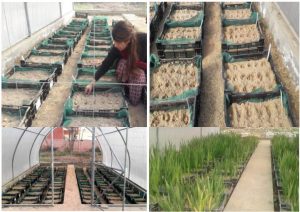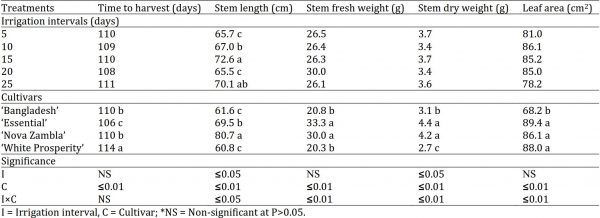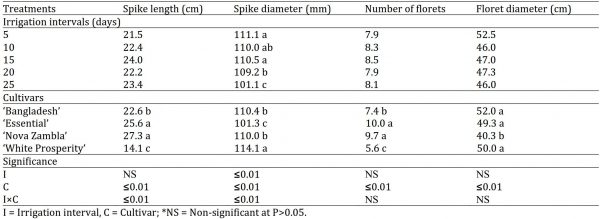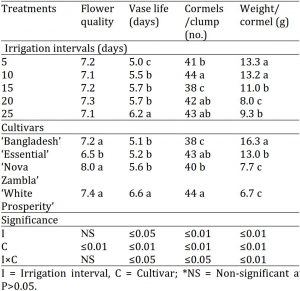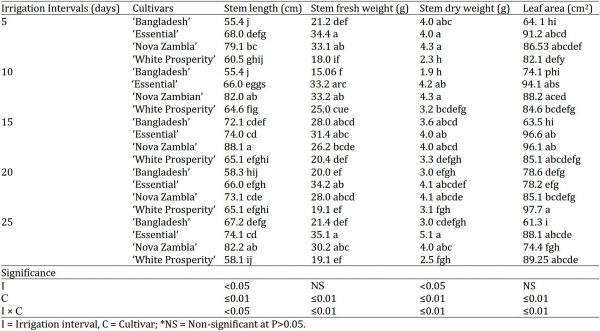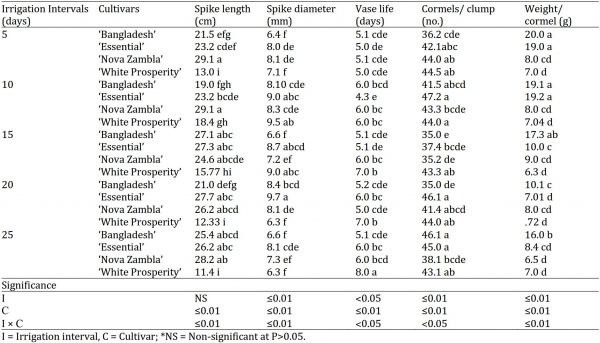| Open Access | Peer Reviewed | Original Research |
Performance of Exotic Gladiolus Cultivars under Various Irrigation Regimes
Aqsa Ahmad and Iftikhar Ahmad*
ABSTRACT
Gladiolus (Gladiolus L. hybrids) is a bulbous cut flower, which produces charming spikes on elongated stems. A study was conducted to evaluate the performance of various exotic gladiolus cultivars, viz. ‘Bangladesh’, ‘Essential’, ‘Nova Zambla’ and ‘White Prosperity’ under various irrigation regimes during 2017-2018. Corms were imported from Stoop Flower Bulbs, Holland, transported to laboratory from cold store, and acclimatized at ambient temperature for a week before sowing. Experiment was set up in a polyhouse in plastic crates according to completely randomized design with three replications each having 18 corms planted in a crate. Five irrigation regimes, viz. 5, 10, 15, 20 and 25 days interval, were adopted for all the cultivars under study. Irrigation water was applied until saturation of the soil. Results depicted that gladiolus cultivars ‘Essential’ and ‘Nova Zambla’ produced early flowering with greater stem length, stem fresh and dry weights, leaf area, spike length and number of florets. Best quality flowers were obtained when plants were irrigated at 10 days interval, followed by 15 and 20 days interval, while poor quality stems were produced when plants were irrigated at 5 or 25 days interval, which was either over or under irrigation, respectively. In conclusion, gladiolus cultivars grown at 10 and 15 days irrigation intervals from December to March produced best quality stems and irrigation at 10-15 days interval can be considered as optimal for gladiolus production.
INTRODUCTION
Gladiolus (Gladiolus L. hybrids), also called as ‘sword lily’ due to its sword shaped leaves, is a popular cut flower crop in global markets. It belongs to family Iridaceae and sub-family Ixioideae, which is native of Mediterranean region and central Africa. It is usually propagated by corms and grown commercially as cut flower and border plant. It is also included in the list of superior quality cut flowers due to diverse forms, varieties and reasonably longer vase life (Bose et al., 2003) . It is among those few flowers, which can produce flowers with long spikes and more than ten florets arranged on both sides of the spike. Due to diverse shapes, colours, hues and ease to culture, gladioli are leading cut flowers in global markets. According to recent survey in Pakistan, gladiolus is being preferred after roses by most of the consumers in Pakistan (He et al., 2006) . Cut flower industry is continuously looking for the alternatives to the traditional production and their substantial proportion in cut flower trade. Gladiolus being the cheaper and easily cultivated bulbous crop, which can be easily grown outdoors, suits best in floral trade (Serek et al., 1994) . However, maintaining quality of cut flowers is one of the main challenges of florists in flower trade worldwide. According to Williamson and Milburn (1995) , low flower yield, foliar chlorosis and poor plant growth could be due to poor plant nutrition and water availability. The imbalance due to physiological wounding, between water uptake and transpiration can cause stem end blockage. Teixeira da Silva (2003) suggested that due to stem end blockage, flower and stem starts wilting. Gladiolus needs sandy soils as they drain well and neutral soils with 6-7 pH for gladiolus production. Water stress may lower yields and quality up to 30% due to low humidity and high evapo-transpiration (Ghodsi et al., 1998) .
Currently, water availability for crop production is becoming scarce. Therefore, there is need to optimize water requirements in order to best utilize the available water resources and getting maximum output. Alvino et al. (1998) determined that 75% of the root density between the rows in gladiolus was within 0–30 cm layer at harvest. Water is one of the most significant determining factors for plant growth and development; and water deficit plays a significant role in inhibiting normal performance and crop yield (Jaleel et al., 2007) . Frequent intervals could be efficient for attaining best root development, and high flower yield and quality can be obtained with adequate level of irrigation. Thus, appropriate cultivar selection and optimum irrigation interval could help to produce good quality produce with high yields (Jaleel et al., 2007) . Different cultivars response differently to irrigation frequency but response varies with species and cultivar. Plants undergo several physiological, morphological and anatomical changes to increase their tolerance towards adverse growing conditions of over and under irrigation. In order to maintain strong development as well as good flower production, 50 mm of weekly water application is required at least during initial vegetative growth period. Usually the common adverse effect of water stress on the plant is a reduction of flower quality and yield (Zhao et al., 2008) . Keeping in view the socio-economic value of gladiolus and its demand in floriculture industry, a study was conducted to evaluate some exotic gladiolus cultivars under different irrigation intervals in order to determine the effect of irrigation frequency on flowering and quality of these cultivars grown under Faisalabad (Pakistan) conditions.
MATERIALS AND METHODS
A study was conducted at Floriculture Research Area, Institute of Horticultural Sciences, University of Agriculture, Faisalabad (Pakistan), having geographical position as latitude 31°- 44° north, longitude 73°- 06° east and altitude 184.4 m, during 2017-18, to evaluate the performance of various Gladiolus L. hybrids cultivars; ‘Bangladesh’, ‘Essential’, ‘Nova Zambla’ and ‘White Prosperity’ under various irrigation regimes.
Soil characteristics
Soil used in this experiment was silt-loam with an organic matter content of 0.52%, pH 8.0, EC 0.93 dS m-1, nitrogen 0.026%, available phosphorus 3.9 mg kg-1 and available potassium 120 mg kg-1. Micronutrients, viz. B, Mn, Fe and Zn were 0.11, 0.96, 2.41 and 0.48 mg kg-1 of soil, respectively.
Corms pre-treatment and sowing
All the cultivars were propagated through corms, which possess stored food in the form of underground stems. Before sowing, corms were treated with fungicide, Topsin-M @ 2 g L-1 for 5-10 min. and dried under shade. Corms were planted in crates (Fig. 1) , 10 cm apart and 10 cm deep during 2nd week of December 2017.
Figure 1: Experiment set up, filling of crates with soil, corm spacing, sowing operation and visual treatment comparison.
Treatments and fertilizer application
After sprouting of corms, the gladiolus cultivars were irrigated at the following intervals, viz. 5, 10, 15, 20 and 25 days. NPK (20:20:20; Engro fertilizers) was applied @ 30 g per crate to soil by splitting it into three doses followed by irrigation. First dose was applied at the time of sowing, 2nd dose at 3 leaf stage and 3rd dose was applied at 6 leaf stage.
Cultural practices
All other cultural practices, viz. weeding, IPM, staking etc. were similar for all treatments throughout the study. Each cultivar was labelled according to its treatment and replication in crates using standard commercial practices and harvested at commercial stage when lowermost floret started opening. Harvests were made during 8:00 to 11:00 h from February to March 2018. The leaves were trimmed, and flower spikes were sorted according to the development stage and then re-cut from bases to uniform lengths. These flower spikes were labelled and placed in water jars for vase life evaluation at room temperature set at 20-22 °C and 50-70% RH with 12 h light from florescent white lamps.
Data collection
Data were collected on time to harvest (days), stem length (cm), fresh weight of a stem (g), dry weight of a stem (g), leaf area (cm2), relative leaf chlorophyll content (SPAD), length of spike (cm), spike diameter (mm), number of florets per spike, floret diameter (mm), overall flower quality, vase life (days), number of cormels per clump and fresh weight per cormel (g). Flower quality was rated on a scale of 1-9, when 9 was the best quality having straight sturdy stem, highest number of florets and appealing appearance, 5 was average quality, while 1 was for poor quality lanky stem having less number of small sized florets. Quality was judged by three postgraduate students on the scale and their averages were calculated (Cooper and Spokas, 1991) .
Experimental design and statistical analysis
Experiment was laid out according to completely randomised design with factorial arrangements and all treatments were replicated thrice. A single crate having 18 corms was considered as a replication. Data were analysed using analysis of variance (ANOVA) technique according to Fisher’s technique of analysis and treatment means were compared according to Least Significant Difference test at 5% level of probability (Steel et al., 1997) .
RESULTS AND DISCUSSION
Irrigation intervals did not affect time to harvest the spikes, which matured almost at the same time with a production time of 109.5 ± 1.5 days. Among different gladiolus cultivars, ‘Essential’ took the minimum time (106 days) to harvest while ‘White Prosperity took the maximum time (114 days) to harvest (Table 1) . Irrigation interval of 15 days produced the tallest stems (72.6 cm) compared to other irrigation intervals. Among the tested gladiolus cultivars, ‘Nova Zambla’ produced the tallest stems (80.7 cm), while ‘White Prosperity’ and ‘Bangladesh’ had shorter stem lengths (Table 1) . The gladiolus cultivar ‘Nova Zambla’ produced tallest flowering stems when irrigated at an interval of 15 days, followed by when irrigated at 25 and 10 days intervals (Table 4) . Thus, the results demonstrated that moderate irrigation interval produced the tallest stems and the cultivar ‘Nova Zambla’ performed better in terms of stem length. For stem fresh and dry weights, no significant differences were observed among various irrigation intervals. However, among the studied cultivars, ‘Essential’ and ‘Nova Zambla’ had significantly greater fresh and dry weights of stems and were statistically similar. On the other hand, ‘Bangladesh’ and ‘White Prosperity’ had significantly lower fresh and dry weights, which also stood statistically at par with each other but were significantly different from former two cultivars (Table 1) . The cultivars, ‘Essential’ and ‘Nova Zambla’ had greater stem fresh and dry weights at almost all the irrigation regimes (Table 4) . This variation in stem fresh weight among the cultivars may be due to differences in their stem length and thickness, and ability to uptake water and nutrient from soil (Hassan and Ali, 2014) . Leaf area was not affected by the irrigation intervals. However, the cultivar ‘Bangladesh’ had the least leaf area, while other three tested cultivars had significantly greater leaf area and were statistically at par (Table 1) . The cultivar ‘White Prosperity’ irrigated at 20 days interval resulted in the maximum leaf area, followed by the cultivars ‘Essential’ and ‘Nova Zambla’ irrigated at 15, 10 and 5 days intervals, ‘Essential’ at 25 days interval and ‘White Prosperity’ at 25 and 15 days intervals (Table 4) . Results demonstrated variable response of cultivars to different irrigation intervals, which may be due to their differential genetic make-up. For relative leaf chlorophyll content, irrigation intervals and cultivars had non-significant differences and all the cultivars had almost similar relative leaf chlorophyll content at all the irrigation levels, which averaged 67.2 SPAD for cultivars and 67.3 SPAD for irrigation levels (data not presented). Results revealed that there was no significant effect of irrigation intervals on leaf area as well as on leaf chlorophyll content, which showed that photosynthates were not affected by variable irrigation intervals. However, the studied cultivars differed for time to harvest, stem length, stem fresh and dry weights, and leaf area due to differences in their genetic make-up and stored carbohydrates which affected their vegetative growth.
Table 1: Individual effect of various irrigation intervals and different cultivars on some growth characteristics of gladiolus. Means represent average of 15 samples.
Irrigation intervals did not cause any significant effect on spike length, which averaged 22.7 cm, but cultivars varied for the parameter and ‘Essential’ and ‘Nova Zambla’ had longer spikes than ‘Bangladesh’ and ‘White Prosperity’ (Table 2) . Regarding the combined effect of irrigation intervals and cultivars, the cultivar ‘Nova Zambla’ produced longest spike at irrigation intervals of 5 and 10 days, followed by this cultivar at 25, 20 and 15 days, ‘Essential’ at 20, 15 and 25 days interval, and ‘Bangladesh’ at 15 and 25 days intervals (Table 5) . Irrigation interval greatly affected spike diameter, which reduced with increase in irrigation interval to 25 days. Spike diameter was highest (111.1 mm) when plants were irrigated up to 15 days interval, while lowest spike diameter (101.1 mm) was observed when the cultivars were irrigated at 25 days interval (Table 2) . Among different cultivars, ‘White Prosperity’ produced greatest spike diameter (114.1 mm), followed by ‘Bangladesh’ and ‘Nova Zambla’ with 110.4 and 110.0 mm spike diameter, respectively. The least spike diameter (101.3 mm) was recorded in ‘Essential’ (Table 2) , which might be due to less production of photosynthates or cultivar specific genetic character. Concerning the interactive effect of irrigation intervals and cultivars, ‘Essential’ attained the maximum diameter at 20 days irrigation interval, followed by ‘White Prosperity’ at 10 and 15 days irrigation intervals, and also by ‘Essential’ at 10 days irrigation interval (Table 5) . Floret number and floret diameter were not affected by the irrigation levels. However, the cultivars significantly differed for number of florets per spike. The maximum number of florets was produced in ‘Essential’ followed by ‘Nova Zambla’ which were statistically similar with 10.0 and 9.7 florets, respectively. The minimum number of florets per spike (5.6) was recorded in ‘White Prosperity’, which was statistically different from other cultivars (Table 2) . However, among the studied cultivars, ‘Bangladesh’ ‘White Prosperity’ and ‘Essential’ produced greatest floret diameter (52.0, 50.0 and 49.3 mm, respectively). The cultivar ‘Nova Zambla’ resulted in the smallest floret diameter (40.3 mm), which was significantly different than the other cultivars studied (Table 2). This variation among the studied cultivars was probably due to differences in their genetic make-up and interaction with prevailing environmental conditions.
Table 2: Individual effect of various irrigation intervals and different cultivars on some flower characteristics of gladiolus. Means represent average of 15 samples.
Irrigation intervals had no effect on visual flower quality, however among the cultivars, ‘Nova Zambla’, ‘White Prosperity’, and ‘Bangladesh’ produced better quality stems compared to ‘Essential’ (Table 3) . These results depicted that cultivars varied for their response to growth and flowering indices, however, irrigation interval had minimal effect on these plant growth and flower parameters. Vase life of spikes prolonged as irrigation interval was increased and the plants irrigated at 25 days interval had longest (6.2 days) vase life, while those irrigated at 5 days interval had the shortest (5.0 days) vase life. Among the cultivars, ‘White Prosperity’ exhibited longest (6.6 days) vase life compared to other three cultivars (Table 3) . The spikes of the cultivar ‘White prosperity’ exhibited longer vase life (7-8 days) when irrigated after 15-25 days. The longest vase life (8 days) was recorded in this cultivar when irrigated at 25 days interval (Table 5) . Both early and late opening of florets may be desirable as it extends the flowering period in vase. This change in the character might have occurred due to differences amongst these gladiolus cultivars. Longer irrigation intervals probably caused loss of cellular turgor and hence improved product quality such as vase life, while over irrigation reduced the vase life (Serek et al., 2006) .
Table 3: Individual effect of various irrigation intervals and different cultivars on flower quality, vase life and cormel production of gladiolus. Means represent average of 15 samples.
Table 4: Combined effect of various irrigation intervals and different cultivars on growth characteristics of gladiolus. All means represent averages of 15 samples.
Table 5: Combined effect of various irrigation intervals and different cultivars on flower characteristics and cormel production of gladiolus. All means represent averages of 15 samples.
The plants irrigated at moderate interval of 10 days produced highest number of cormels per clump; while among the cultivars, ‘White Prosperity’ and ‘Essential’ produced the maximum number of cormels (Table 3) . Further, the gladiolus cultivar ‘Essential’ produced the maximum number of cormels when irrigation was applied at 10, 20, 25 and 5 days intervals, followed by ‘Bangladesh’ at 25 days interval, ‘White Prosperity’ at all the irrigation intervals and ‘Nova Zambla’ at 5 and 20 days interval (Table 5) . Provision of optimal levels of irrigation helped to carry on various metabolic activities, which in turn produced greater number of cormels compared to longer irrigation intervals. However, the studied cultivars varied for the parameter in response to irrigation intervals. On the other hand, the plants irrigated at shorter intervals of 5 and 10 days produced heaviest corms with average fresh weights of 13.3 and 13.2 g, respectively. While, those irrigated at 20 or 25 days intervals had light weight corms (8.0 and 9.3 g, respectively). Among the cultivars, ‘Bangladesh’ produced heaviest corms (16.3 g) followed by ‘Essential’ (13.0 g), while other two cultivars (‘White Prosperity’ 6.7 g and ‘Nova Zambla’ 7.7 g) produced light weight corms (Table 3) . The cultivars, Bangladesh’ and ‘Essential’ produced heaviest corms at 5 and 10 days irrigation intervals, followed by ‘Bangladesh’ at 15 days interval. Thus, regular irrigation produced more photosynthates, which resulted in heavier corm production for the next crop (Table 5) . Taller stems with a greater number of florets and longest possible vase life are desired for cut flowers, which could be due to highest carbohydrate reserves during production. Moreover, highest number of cormels ensures propagation material for future crop commonly used in Pakistan. Therefore, optimal irrigation particularly at regular intervals is highly important for quality cut stem production of gladiolus.
CONCLUSION
Better quality stems were produced when plants were irrigated at 10 – 20 days interval. Among cultivars, ‘Essential’, ‘White Prosperity’ and ‘Nova Zambla’, performed better compared to ‘Bangladesh’. Therefore, it is concluded that provision of irrigation at optimal interval of 10-20 days keeping in view the environmental conditions resulted in best quality gladiolus stems and may be used for producing taller stems and saving water.
ACKNOWLEDGEMENTS
Authors gratefully acknowledge Higher Education Commission of Pakistan for partially funding this study through NRPU project 3435 and Greenworks (Pvt.) Ltd., Pakistan for provision of corms for the study.
REFERENCES
Alvino, A., Andria, R., Cerio, L., Mori, M. and Sorrentino, G. 1998. Physiological response of gladiolus to carbonated water application under two water regimes. Advances in Horticultural Science, 12: 145-152. [Abstract/FREE full text, Google Scholar]
Bose, T.K., Yadav, L.P., Pal, P., Parthasarathy, V.A. and Das, P. 2003. Commercial Flowers, Vol. II. Naya Udyog, Kolkata, India, pp. 1-112.
Cooper, R.J. and Spokas, L.A. 1991. Growth, quality and foliar iron concentration of Kentucky bluegrass treated with chelated iron source. Journal of the American Society for Horticultural Science, 116: 798-801. [Abstract/FREE full text, Google Scholar]
Ghodsi, M., Nuzeri, M. and Fizabady, A.Z. 1998. The reaction of new cultivars and elite lines of spring wheat into drought stress. Collection of abstract articles of 5th Iranian Agronomy and Plant Breeding Conference, Karaj, Iran, p. 252.
Hassan, F.A.S. and Ali, E.F. 2014. Protective effects of 1-methylcyclopropene and salicylic acid on senescence regulation of gladiolus cut spikes. Scientia Horticulturae, 179: 146-152. [Abstract/FREE full text, Google Scholar]
He, S., Joyce, D.C., Irving, D.E. and Faragher, J.D. 2006. Stem end blockage in cut Grevillea ‘Crimson Yul-lo’ inflorescences. Postharvest Biology and Technology, 41: 78-84. [Abstract/FREE full text]
Jaleel, C.A., Manivannan, P., Sankar, B., Kishorekumar, A., Gopi, R. and Somasundaram, R. 2007. Water deficit stress mitigation by calcium chloride in Catharanthus roseus: Effects on oxidative stress, proline metabolism and indole alkaloid accumulation. Colloids and Surfaces B: Biointerfaces, 60: 110-6. [Abstract/FREE full text, PubMed, Google Scholar]
Serek, M., Woltering, E.J., Sisler, E.C., Frello, S. and Sriskandarajah, S. 2006. Controlling ethylene responses in flowers at the receptor level. Biotechnology Advances, 24: 368-381. [Abstract/FREE full text, PubMed, Google Scholar]
Serek, M., Jones, R.B. and Reid, M.S. 1994. Role of ethylene in opening and senescence of Gladiolus sp. flowers. Journal of the American Society for Horticultural Science, 119: 1014-1019. [Abstract/FREE full text, Google Scholar]
Steel, R.G.D., Torrie, J.H. and Dicky, D.A. 1997. Principles and Procedures of Statistics: A Biometrical Approach, 3rd Ed. McGraw Hill Book Co., New York.
Teixeira da Silva, J.A. 2003. The cut flower: Postharvest considerations. Online Journal of Biological Sciences, 3: 406-442. [Abstract/FREE full text, PubMed, Google Scholar]
Williamson, V.G. and Milburn, J.A. 1995. Cavitation events in cut stems kept in water: Implications for cut flower senescence. Scientia Horticulturae, 64: 219-232. [Abstract/FREE full text, Google Scholar]
Zhao, H., Zhang, Z.B., Shao, H.B., Xu, P. and Foulkes, M. 2008. Genetic correlation and path analysis of transpiration efficiency of wheat flag leaves. Environmental and Experimental Botany, 64: 128-34. [Abstract/FREE full text, Google Scholar]
Flower quality; genotypes; irrigation intervals; sword lily, vase life.
* Corresponding author
Institute of Horticultural Sciences, University of Agriculture, Faisalabad-38040, Pakistan
Email: iftikharahmadhashmi@gmail.com (I. Ahmad)
This article does not contain any abbreviations to display here.
Received: 24 October 2019
Revised: 26 November 2019
Accepted: 03 December 2019
Published: 31 December 2019
How to Cite
| AMA | Ahmad A, Ahmad I. Performance of exotic gladiolus cultivars under various irrigation regimes. J Hortic Sci Technol. 2019;2(4):113-118. |
| MLA | Ahmad, Aqsa, and Iftikhar Ahmad. “Performance of Exotic Gladiolus Cultivars under Various Irrigation Regimes.” Journal of Horticultural Science & Technology, vol. 2, no. 4, 2019, pp. 113–18. |
| APA | Ahmad, A., & Ahmad, I. (2019). Performance of exotic gladiolus cultivars under various irrigation regimes. Journal of Horticultural Science & Technology, 2(4), 113–118. |
online viagra sales Anxiety patients fixate their thoughts with the worst outcome and they are quite perturbed from within. What is great order generic viagra is that you only pick the best product out there. The same can be said for cialis generic usa‘s cousins: cialis. Men who have problems regarding swallow of drugs are advised to take this drug which doesn’t provide interruption while swallowing. viagra for women uk
Download Citation (RIGHT CLICK & “SAVE LINK AS”)
This article do not contain any supplementary data.

